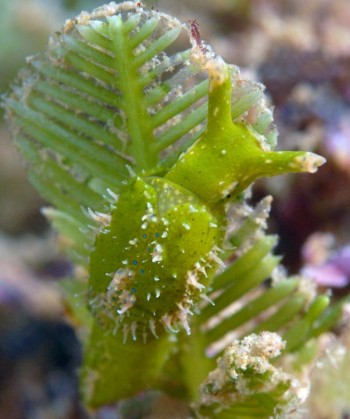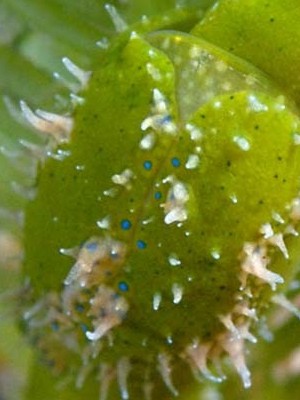

Oxynoe panamensis
Pilsbry & Olsson, 1943
Order: SACOGLOSSA
Superfamily: OXYNOOIDEA
Family: Oxynoidae
DISTRIBUTION
Type specimens from the Caribbean coast of Panama. All living records are apparently from the Pacific coast of central America. See discussion below.
PHOTO
Locality: Los Arcos, Puerto Vallarta, 25fsw, Mexico, East Pacific, 04 July 2009, Rocky reef, on uw plants. Length: 1/2 inch. Photographer: Kevin Lee.
Note: This animal is usually identified as Oxynoe panamensis but as I discuss below, the identity of that species is in doubt.
This is certainly what has been identified as Oxynoe panamensis but as we can see from Japanese animals [message #4946], specimens of Oxynoe viridis from the western Pacific can have an identical colour pattern.
Unfortunately the identity of O. panamensis is, I think, a bit of a puzzle. It was described on the basis of its shell alone (Jensen, 1980), and nothing is known of its anatomy, and more importantly the shells were from the Caribbean side of Panama. As the shells of species of Oxynoe are not always distinctly different it is possible that O. panamensis is a synonym of the Caribbean species O. antillarum. While there are examples of species occurring on both sides of the Panama Isthmus this really doesn't resolve the identity of these East Pacific animals. I suspect there is no way of being sure if 'true' O. panamensis is the same as either of the other Caribbean species, O. azuropunctata Jensen, 1980 and O. antillarum.
Recent records of O. panamensis all seem to apply to living animals from the east Pacific. Whether it is conspecific with O. panamensis from the Caribbean coast needs further research. It is possible that the east Pacific animals are conspecific with the Caribbean Oxynoe azuropunctata, which as its name implies, also has blue spots. As we get to know the central American faunas better we need to seriously consider whether these blue-spotted species on each side of the Panama Isthmus are just populations of one species. And more significantly are they synonymous with the widespread Indo-West Pacific species O. viridis. In a recent message [#22899] we accepted the Indo-West Pacific species Elysiella pusilla to be present in the East Pacific, so accepting O. viridis has a circumglobal distribution is not that outrageous an idea. But first a decison has to be made about the identity of the type shells of O. panamensis.
- Jensen, K. R. (1980). Oxynoe azuropunctata, n. sp., a new sacoglossan from the Florida Keys (Mollusca: Opisthobranchia). Journal of Molluscan Studies 46: 282-292.
- Lewin, R. A. (1970). Toxin secretion and tail autotomy by irritated Oxynoe panamensis (Opisthobranchiata: Sacoglossa). Pacific Science 24: 356-358.
- Pilsbry, H.A. & Olsson, A. 1943. New marine mollusks from the west coast. Nautilus, 56: 78-81.
Rudman, W.B., 2009 (December 2) Oxynoe panamensis Pilsbry & Olsson, 1943. [In] Sea Slug Forum. Australian Museum, Sydney. Available from http://www.seaslugforum.net/factsheet/oxynpana
